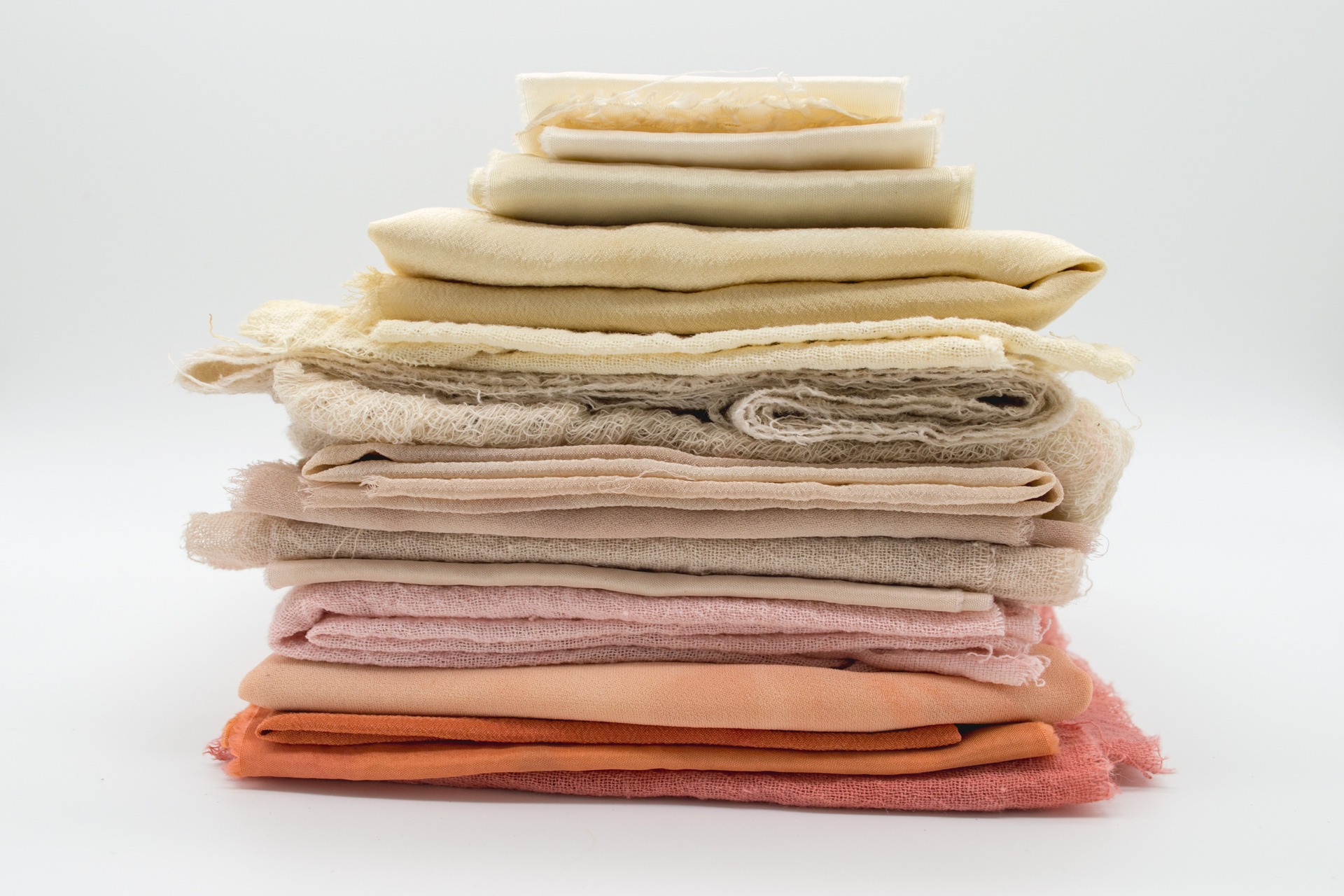
Sustainable Fabric Options for a Better Planet
We are reader-supported. When you buy through links on our site, we may earn affiliate commission.
Sustainable fabric is crucial in the modern world. It offers eco-friendly alternatives to traditional textiles, addressing pressing environmental concerns.
Traditional textile production involves resource-intensive processes and harmful chemicals, contributing to pollution and waste. Sustainable fabrics aim to minimize these impacts, promoting a greener and more responsible approach to fashion and textiles.
1. Organic Cotton
Organic cotton, a sustainable fabric option, grows in environments without synthetic pesticides or genetically modified organisms (GMOs). This method preserves biodiversity and prevents potential long-term consequences associated with genetic modification in agriculture.
Substantially reducing chemical usage promotes cleaner ecosystems and minimizes soil and water contamination. Choosing organic cotton over conventional cotton supports healthier living conditions for farmers, eliminates their exposure to harmful chemicals and often results in softer, more breathable and hypoallergenic textiles.
2. Hemp
Its cultivation requires less water than many other crops, making it an eco-friendly choice in regions facing water scarcity. Hemp also proliferates, typically reaching maturity in a few months, reducing the time and resources for cultivation.
The versatility of hemp extends far beyond its use as a textile material. In addition to clothing, hemp finds applications in various industries, from construction to automotive. In fashion, it offers a unique blend of durability and comfort. It is known for its breathability, moisture-wicking properties and resistance to mold and UV rays, making it ideal for clothing, especially in warm and humid climates.
3. Tencel (Lyocell)
Tencel is a sustainable fabric made of wood pulp from eucalyptus, beech or spruce trees. These materials come from responsibly managed forests, reducing the ecological footprint. The production process employs a closed-loop system, where manufacturers continually recycle the solvents they use to break down the wood pulp.
This fabric boasts comfort, durability and a silky smooth texture that feels gentle against the skin. It makes it an excellent choice for clothing, as its natural resistance to wrinkles also ensures the garments maintain a fresh and polished appearance, even after prolonged wear.
4. Recycled Polyester
It’s a sustainable textile material that is crucial in reducing plastic waste and environmental impact. Recycled polyester comes from recycled plastic bottles and other post-consumer plastic waste, diverting these materials from landfills and oceans.
The production of this sustainable material involves several key steps:
- Collection: Waste management facilities gather and clean post-consumer plastic waste — like used bottles — for recycling.
- Shredding and Melting: The manufacturer shreds the collected plastic into small pieces and then melts it into a liquid polyester.
- Extrusion: Workers extrude molten polyester into fine threads or filaments.
- Cooling and Solidifying: Machines rapidly cool the threads to solidified fibers.
- Cutting and Spinning: Workers cut and spin solid fibers into recycled polyester yarns for various textile applications.
This fabric offers a sustainable alternative to traditional polyester, as it significantly reduces the need for new plastic production and helps mitigate the environmental impact of plastic waste. By closing the recycling loop and repurposing discarded plastics into practical textiles, recycled polyester contributes to a more eco-friendly and circular approach to textile production.
5. Linen
Linen comes from the flax plant, which requires relatively little water and pesticides during cultivation, making it an eco-friendly choice. Furthermore, most flax plant parts are usable, leaving minimal waste in production.
The fabric’s natural moisture-wicking properties and breathability make it ideal for warm weather. It allows air to circulate, keeping the body cool and comfortable, which is especially beneficial during hot summers.
Proper care is essential to extend the life span of linen garments. Here are some tips:
- Gentle washing: Hand wash or use a delicate cycle with a mild detergent to prevent excessive wear and tear.
- Avoid overcrowding: Don’t overcrowd the washing machine, as it can lead to wrinkles and damage.
- Use cold water: Wash linen in cold water to prevent shrinking and color fading.
- Air dry: Hang linen garments to air dry, avoiding direct sunlight. Excessive heat can cause fibers to weaken and deteriorate.
- Iron when damp: For a crisp look, iron linen when it’s still slightly damp. It helps smooth out wrinkles more effectively.
- Store carefully: Keep linen clothing in a cool, dry place, and avoid hanging it in direct sunlight for extended periods.
By following these care tips, individuals can enjoy their linen garments for many years, reducing the need for frequent replacements and contributing to a more sustainable wardrobe.
6. Bamboo
One of the standout features of bamboo is its fast-growing and renewable nature. It can grow astonishingly, sometimes up to a meter daily, without synthetic pesticides or fertilizers. In addition, it is a resilient plant that can thrive in diverse climates, further minimizing its environmental impact.
Bamboo clothing has gained recognition for its softness and comfort. The fibers are naturally smooth and gentle on the skin, creating a luxurious and cozy feel. Moreover, it efficiently absorbs moisture away from the body, keeping the wearer dry and comfortable, making it an excellent choice for activewear and warm-weather clothing.
7. Organic Wool
Producing this sustainable fabric doesn’t use harmful chemicals through a commitment to environmentally friendly and animal-friendly practices.
- Responsible farming: Organic wool comes from sheep on farms following strict organic standards. These farms prioritize the well-being of the animals and avoid using synthetic pesticides, herbicides and genetically modified organisms in their pastures.
- Chemical-free treatment: The sheep do not undergo chemical treatments, such as synthetic dyes, hormones or antibiotics. It ensures the wool remains free from chemical residues.
- Certified organic practices: Farms and wool processing facilities engaged in organic wool production undergo rigorous certification processes to ensure compliance with organic standards. This certification ensures transparency and accountability in the production chain.
Organic wool is famous for its warmth and insulation properties. The wool fibers have natural crimps and pockets that trap air, creating an insulating layer that helps regulate temperature. It means it is effective at keeping people warm in cold weather while also allowing breathability, making it comfortable to wear in various conditions.
The Road to a Greener Future
Every sustainable choice in clothing and textiles reduces the environmental footprint of various industries, which often comes with resource depletion, pollution and waste. Sustainable fabric options help conserve water, minimize chemical use, reduce carbon emissions and support ethical and responsible production practices.
Shoppers have the opportunity to be mindful consumers who vote with their wallets for a better world. By making informed choices, they encourage manufacturers and brands to prioritize sustainable practices and materials. Their decisions benefit the environment and promote fair labor conditions and ethical production standards.
Share on
Like what you read? Join other Environment.co readers!
Get the latest updates on our planet by subscribing to the Environment.co newsletter!
About the author
Steve Russell
Steve is the Managing Editor of Environment.co and regularly contributes articles related to wildlife, biodiversity, and recycling. His passions include wildlife photography and bird watching.





